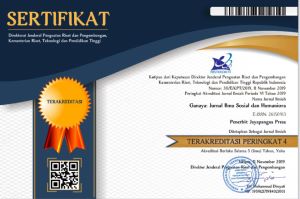The Role of Safety Leadership in the Influence of Safety Coaching and Safety Engagement on Safety Performance
DOI:
https://doi.org/10.37329/ganaya.v7i2.3748Keywords:
Safety Leadership, Safety Coaching, Safety Engagement, Safety Performance, Occupational Health, Safety ProfessionalAbstract
Occupational safety and health professionals play an important role in improving workplace safety. However, the effectiveness of safety leadership, safety coaching and engagement in improving safety performance, mediated by safety culture, remains under-researched. This study aims to analyze how these factors influence safety performance among occupational safety and health professionals in Riau Islands Province, Indonesia. This study used a structural equation modelling (SEM) approach for hypothesis testing based on data collected from 180 active occupational safety and health professionals using purposive sampling. The results showed that all hypotheses were supported: safety leadership mediated the relationship between safety training and safety engagement with safety performance. This suggests that leadership is important in fostering a safety culture and encouraging proactive employee engagement. In addition, safety training was found to significantly influence leadership and safety performance. The results of this study conclude that strengthening leadership and engagement in safety through targeted coaching and training can significantly improve safety outcomes in high-risk industries. The findings underscore the importance of integrating safety leadership and culture into organizational practices. Future research should explore the long-term impact of safety leadership interventions and the potential for cross-industry application to further improve workplace safety standards.
References
Avkiran, N. K. (2018). An In-Depth Discussion and Illustration Of Partial Least Squares Structural Equation Modeling In Health Care. Health Care Management Science, 21, 401-408.
Barling, J., Loughlin, C., & Kelloway, E. K. (2002). Development And Test of A Model Linking Safety-Specific Transformational Leadership And Occupational Safety. Journal of Applied Psychology, 87(3), 488–496.
Bass, B. M., & Avolio, B. J. (2000). MLQ: Multifactor Leadership Questionnaire. Redwood City: Mind Garden.
Behm, M. (2005). Linking Construction Fatalities To The Design For Construction Safety Concept. Safety Science, 43(8), 589-611.
Blair, M. (2002). Effective School Leadership: The Multi-Ethnic Context. British Journal of Sociology of Education, 23(2), 179-191.
Dansereau, J. F., Graen, G., & Haga, W. J. (1975). A Vertical Dyad Linkage Approach To Leadership Within Formal Organizations: A Longitudinal Investigation Of The Role Making Process. Organizational Behavior and Human Performance, 13(1), 46-78.
Ellinger, A. E., Ellinger, A. D., & Keller, S. B. (2005). Supervisory Coaching in A Logistics Context. International Journal of Physical Distribution & Logistics Management, 35(9), 620-636.
Fang, D., & Wu, H. (2013). Development Of A Safety Culture Interaction (Sci) Model For Construction Projects. Safety Science, 57, 138–149.
Hagen, M., & Gavrilova Aguilar, M. (2012). The Impact Of Managerial Coaching On Learning Outcomes Within The Team Context: An Analysis. Human Resource Development Quarterly, 23(3), 363-388.
Hair, J. J. F., Sarstedt, M., Hopkins, L., & Kuppelwieser, V. G. (2014). Partial Least Squares Structural Equation Modeling (PLS-SEM): An Emerging Tool In Business Research. European Business Review, 26(2), 106-121.
Hair, J. J. F., Hult, G. T. M., Ringle, C. M., Sarstedt, M., Danks, N. P., & Ray, S. (2021). Partial Least Squares Structural Equation Modeling (PLS-SEM) Using R: A Workbook (p. 197). Springer Nature.
Hamlin, R. G., Ellinger, A. D., & Beattie, R. S. (2006). Coaching At The Heart Of Managerial Effectiveness: A Cross-Cultural Study Of Managerial Behaviours. Human Resource Development International, 9(3), 305-331.
Harter, J. K., Schmidt, F. L., Killham, E. A., & Asplund, J. W. (2006). Q12 Meta-Analysis. The Gallup Organization, Mimeo.
Kim, S. (2014). Assessing The Influence of Managerial Coaching On Employee Outcomes. Human Resource Development Quarterly, 25(1), 59-85.
Lee, J. (2005). Effects Of Leadership and Leader‐Member Exchange On Commitment. Leadership & Organization Development Journal, 26(8), 655-672.
Liden, R. C., & Maslyn, J. M. (1998). Multidimensionality Of Leader-Member Exchange: An Empirical Assessment Through Scale Development. Journal of management, 24(1), 43-72.
Liu, X., & Batt, R. (2010). How Supervisors Influence Performance: A Multilevel Study Of Coaching And Group Management In Technology‐Mediated Services. Personnel Psychology, 63(2), 265-298.
McNeish, D. (2018). Thanks Coefficient Alpha, We’ll Take It from Here. Psychological Methods, 23, 412–433.
Neal, A., Griffin, M. A., & Hart, P. M. (2000). The Impact Of Organizational Climate On Safety Climate And Individual Behavior. Safety Science, 34(3), 99-109.
Neal, A., & Griffin, M. A. (2006). A Study Of The Lagged Relationships Among Safety Climate, Safety Motivation, Safety Behavior, And Accidents At The Individual And Group Levels. Journal Of Applied Psychology, 91(4), 946.
Nelson, D. L., & Cooper, C. L. (2012). Positive Organizational Behavior: Accentuating The Positive At Work. Thousand Oaks, CA: Sage Publishing.
Pallant, J. (2016). SPSS Survival Manual (6th ed.). McGraw-Hill Education.
Pousa, C., & Mathieu, A. (2014). Boosting Customer Orientation Through Coaching: A Canadian Study. International Journal of Bank Marketing, 32(1), 60-81.
Pousa, C. E. (2012). The Impact Of Coaching On Salesperson's Performance And The Mechanisms That Regulate This Relationship (Doctoral dissertation, Université de Sherbrooke).
Raines, M. S. (2011). Engaging Employees: Another Step in Improving Safety. Professional Safety, 56(4), 36–43.
Reason, J. (1995). A Systems Approach To Organizational Error. Ergonomics, 38(8), 1708-1721.
Skeepers, N. C., & Mbohwa, C. (2015). A Study on The Leadership Behaviour, Safety Leadership And Safety Performance In The Construction Industry In South Africa. Procedia Manufacturing, 4, 10-16.
Trépanier, C. (2010). Le Coaching Du Directeur Et La Performance Du Vendeur: Une Approche Relationnelle. Université de Sherbrooke.
Vance, R. J. (2006). Employee Engagement And Commitment: A Guide To Understanding, Measuring And Increasing Engagement In Your Organization. SHRM Foundation.
Wu, T. C. (2005). The Validity And Reliability Of Safety Leadership Scale In Universities of Taiwan. International Journal of Technology and Engineering Education, 2(1), 27-42.
Wu, T. C., Chen, C. H., & Li, C. C. (2008). A Correlation Among Safety Leadership, Safety Climate And Safety Performance. Journal Of Loss Prevention In The Process Industries, 21(3), 307-318.
Wu, C., Wang, F., Zou, P. X., & Fang, D. (2016). How Safety Leadership Works Among Owners, Contractors And Subcontractors In Construction Projects. International Journal Of Project Management, 34(5), 789-805.
Walker, A., & Hutton, D. M. (2006). The Application Of The Psychological Contract To Workplace Safety. Journal Of Safety Research, 37(5), 433-441.
Wilderom, C. P., Van, D. B. P. T., & Wiersma, U. J. (2012). A Longitudinal Study Of The Effects Of Charismatic Leadership And Organizational Culture On Objective And Perceived Corporate Performance. The Leadership Quarterly, 23(5), 835-848.
Wu, T. C. (2008). Safety Leadership In The Teaching Laboratories Of Electrical And Electronic Engineering Departments At Taiwanese Universities. Journal Of Safety Research, 39(6), 599-607.
Wu, T. C., Chang, S. H., Shu, C. M., Chen, C. T., & Wang, C. P. (2011). Safety Leadership and Safety Performance in Petrochemical Industries: The Mediating Role Of Safety Climate. Journal of Loss Prevention in the Process Industries, 24(6), 716-721.
Xu, J., & Cooper Thomas, H. (2011). How Can Leaders Achieve High Employee Engagement?. Leadership & Organization Development Journal, 32(4), 399-416.
Yousef, D. A. (2000). Organizational Commitment: A Mediator Of The Relationships Of Leadership Behavior With Job Satisfaction And Performance In A Non‐Western Country. Journal of managerial Psychology, 15(1), 6-24.
Yuan, B. J., Lin, M. B., Shieh, J. H., & Li, K. P. (2012). Transforming Employee Engagement Into Long-Term Customer Relationships: Evidence From Information Technology Salespeople In Taiwan. Social Behavior & Personality: An International Journal, 40(9), 1549-1553.
Zohar, D. (2002). The Effects Of Leadership Dimensions, Safety Climate, And Assigned Priorities On Minor Injuries In Work Groups. Journal Of Organizational Behavior, 23(1), 75-92.
Downloads
Published
How to Cite
Issue
Section
License
Copyright (c) 2024 Febrian Hermawan, Agustinus Setyawan, Lily Sudhartio (Author)

This work is licensed under a Creative Commons Attribution-ShareAlike 4.0 International License.
An author who publishes in the Ganaya : Jurnal Ilmu Sosial dan Humaniora agrees to the following terms:
- Author retains the copyright and grants the journal the right of first publication of the work simultaneously licensed under the Creative Commons Attribution-ShareAlike 4.0 License that allows others to share the work with an acknowledgement of the work's authorship and initial publication in this journal
- Author is able to enter into separate, additional contractual arrangements for the non-exclusive distribution of the journal's published version of the work (e.g., post it to an institutional repository or publish it in a book) with the acknowledgement of its initial publication in this journal.
- Author is permitted and encouraged to post his/her work online (e.g., in institutional repositories or on their website) prior to and during the submission process, as it can lead to productive exchanges, as well as earlier and greater citation of the published work (See The Effect of Open Access).
Read more about the Creative Commons Attribution-ShareAlike 4.0 Licence here: https://creativecommons.org/licenses/by-sa/4.0/.








